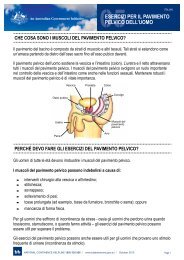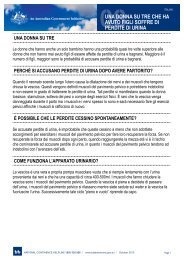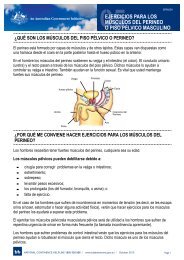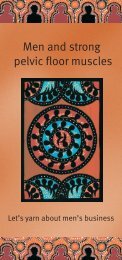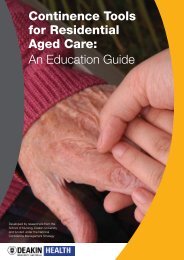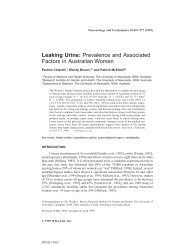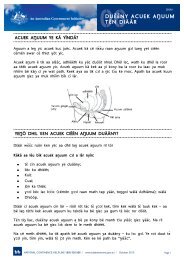Pharmacy Continence Care - Bladder and Bowel Website
Pharmacy Continence Care - Bladder and Bowel Website
Pharmacy Continence Care - Bladder and Bowel Website
Create successful ePaper yourself
Turn your PDF publications into a flip-book with our unique Google optimized e-Paper software.
1 INTRODUCTION<br />
1.1 Background <strong>and</strong> rationale<br />
Incontinence is a significant health issue that affects women <strong>and</strong> men of all ages <strong>and</strong><br />
backgrounds, as well as children, with physical, social <strong>and</strong> economic implications for the<br />
individual, carers <strong>and</strong> the community.<br />
Incontinence is a common health problem affecting over 2 million Australians, affecting one<br />
in 10 Australians, including up to 40 per cent of people over 75 years. Many more Australians<br />
are affected by the condition as carers of people with urinary or faecal incontinence.<br />
Despite the prevalence of incontinence <strong>and</strong> the considerable impacts bladder <strong>and</strong> bowel<br />
problems have on the health <strong>and</strong> wellbeing <strong>and</strong> cost of living of the individual with<br />
incontinence, their family <strong>and</strong> carers, it is estimated that less than 50 per cent of people<br />
affected seek help. This common condition is one of the biggest health issues in the<br />
Australian community, affecting more than two million Australians. The <strong>Continence</strong><br />
Foundation suggests that:<br />
• 60-70 per cent of those affected could be cured or much better managed<br />
• an estimated 50 per cent of people affected do not discuss their incontinence, even with<br />
their GPs<br />
• incontinence is one of the three major causes (along with mobility <strong>and</strong> dementia) for<br />
admittance to an aged care home.<br />
In 2001 the Department of Health <strong>and</strong> Ageing, under the National <strong>Continence</strong> Management<br />
Strategy, funded the Hunter <strong>Continence</strong> Awareness Project. Partners for that project<br />
included The <strong>Pharmacy</strong> Guild of Australia <strong>and</strong> the <strong>Continence</strong> Foundation of Australia. A<br />
model of coordinated care amongst GPs, pharmacists, continence nurses <strong>and</strong> other health<br />
professionals was developed.<br />
There are about 5,000 community pharmacies <strong>and</strong> it is estimated that about 400,000 people<br />
visit a community pharmacy each day. Pharmacies therefore are positioned to become, <strong>and</strong><br />
be recognised, as the most commonly access health service provider with the capacity to<br />
promote continence awareness <strong>and</strong> to offer support <strong>and</strong>/or referral to individuals with<br />
incontinence symptoms who have not sought diagnosis, advice or treatment.<br />
<strong>Pharmacy</strong> <strong>and</strong> consumer awareness, together with effective information, advice <strong>and</strong> referral<br />
of people with incontinence symptoms <strong>and</strong>/or their carers, has the potential to reduce<br />
significantly the extent to which incontinence remains under-reported, with consequent<br />
benefits to the quality of life of individuals with incontinence, <strong>and</strong> their families <strong>and</strong> carers,<br />
<strong>and</strong> to the cost impacts of incontinence on government services.<br />
In 2003, the <strong>Pharmacy</strong> Guild commissioned developmental work towards the establishment<br />
of a national <strong>Pharmacy</strong> <strong>Continence</strong> <strong>Care</strong> Program, through the Research <strong>and</strong> Development<br />
Grants Program, which was funded as part of the third Community <strong>Pharmacy</strong> Agreement<br />
between the Commonwealth <strong>and</strong> the <strong>Pharmacy</strong> Guild of Australia. Two stages in the<br />
development of this program have been commissioned.<br />
Stage 1 of the <strong>Pharmacy</strong> <strong>Continence</strong> <strong>Care</strong> Program was undertaken in 2003 by the<br />
<strong>Continence</strong> Advisory Service of WA Inc. This project included a literature review with the<br />
brief to identify current best practice in continence care in community pharmacies in<br />
Australia <strong>and</strong> internationally <strong>and</strong> to research <strong>and</strong> develop pharmacy continence care resource<br />
Final Report<br />
1<br />
NOVA Public Policy<br />
<strong>Pharmacy</strong> <strong>Continence</strong> <strong>Care</strong> Project



